Shark OXO helmet review
Published on: 10 December 2024
CLICK SHARK OXO HELMET TO SHOP WITH FREE UK NEXT DAY DELIVERY
I think it would not be unfair to suggest that the style of helmet that Shark is most famous for is the 'flip-over' helmet, of which the Shark OXO helmet is the latest iteration. I feel sure that the company's head honchos would like to believe that they are better known for their high-end, sports helmets. After all, they have been into racing from the very early days. Carl Fogarty wore a Shark when he won world championships for Ducati back in the nineties. And certainly the company seems inordinately excited by its latest Aeron GP helmet with its 'adaptive' flaps to reduce drag at speed.
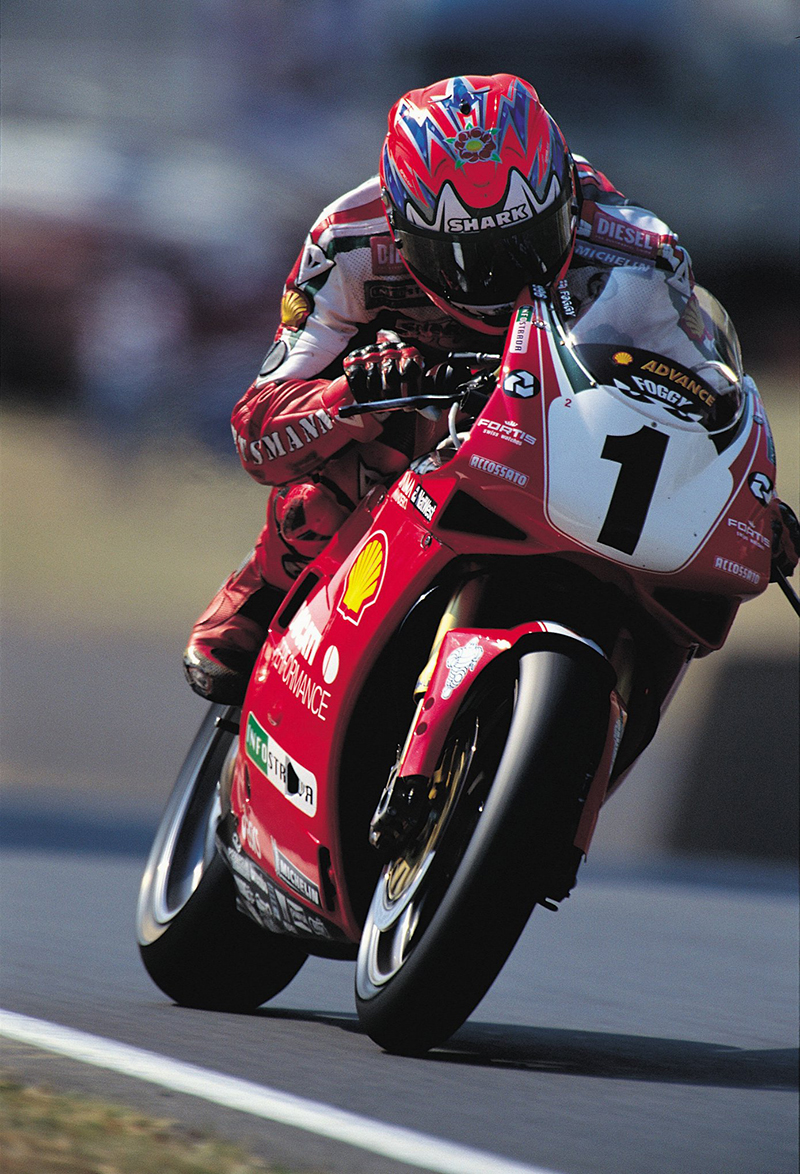
But the reality is a little more prosaic. Think about Shark helmets, and you think of all those couriers and commuters in their 'flip-over' helmets. For those who ride into Europe's big cities this style of helmet has become somewhat ubiquitous. Whether you're in Paris, Milan, Madrid or Athens, there's a good chance that the rider of the scooter that is weaving in and out of the traffic, like a man or woman possessed, is wearing a Shark. They're pretty popular with the European Police too. (The helmet that is, not those mad scooterists).
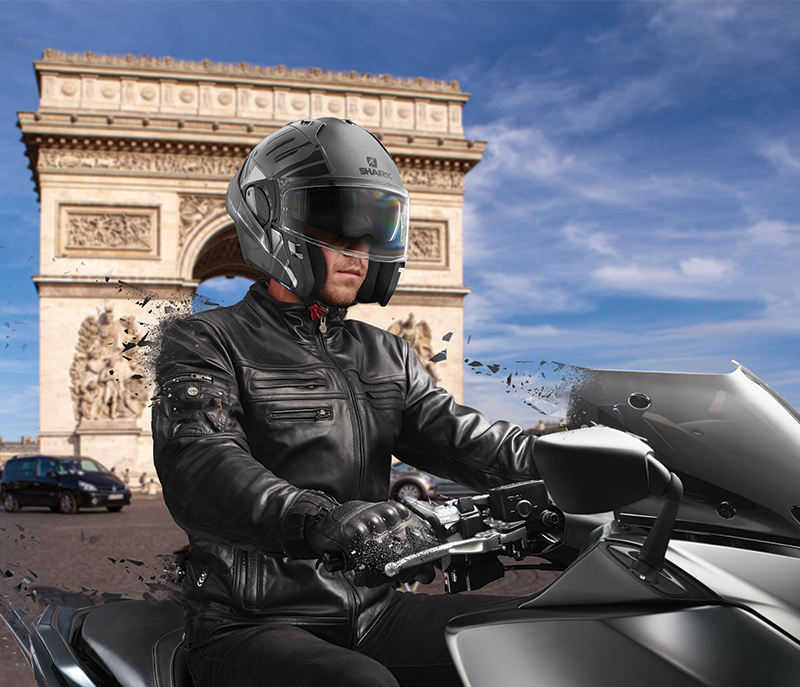
And indeed for the urban commuter, a flip-over might just be the perfect helmet, combining the protection of a full-face helmet when you're on your way into town from the suburbs, with the cooling and visibility benefits of an open-face helmet when you're inside the city limits.
Anyway, let's go back a little, and look at the evolution of the flip-over helmet because, even though Shark has owned this territory in recent years, that wasn't always the case.
The history behind the Shark OXO
Shark did not invent the flip-over helmet. That particular accolade must go to fellow Frenchman Claude Morin, whose Roof operation came up with the concept in 1997. Indeed that helmet, the Boxer, became one of the most popular and iconic styles in the motorcycle world, selling in its millions to bikers of all persuasions across the globe.
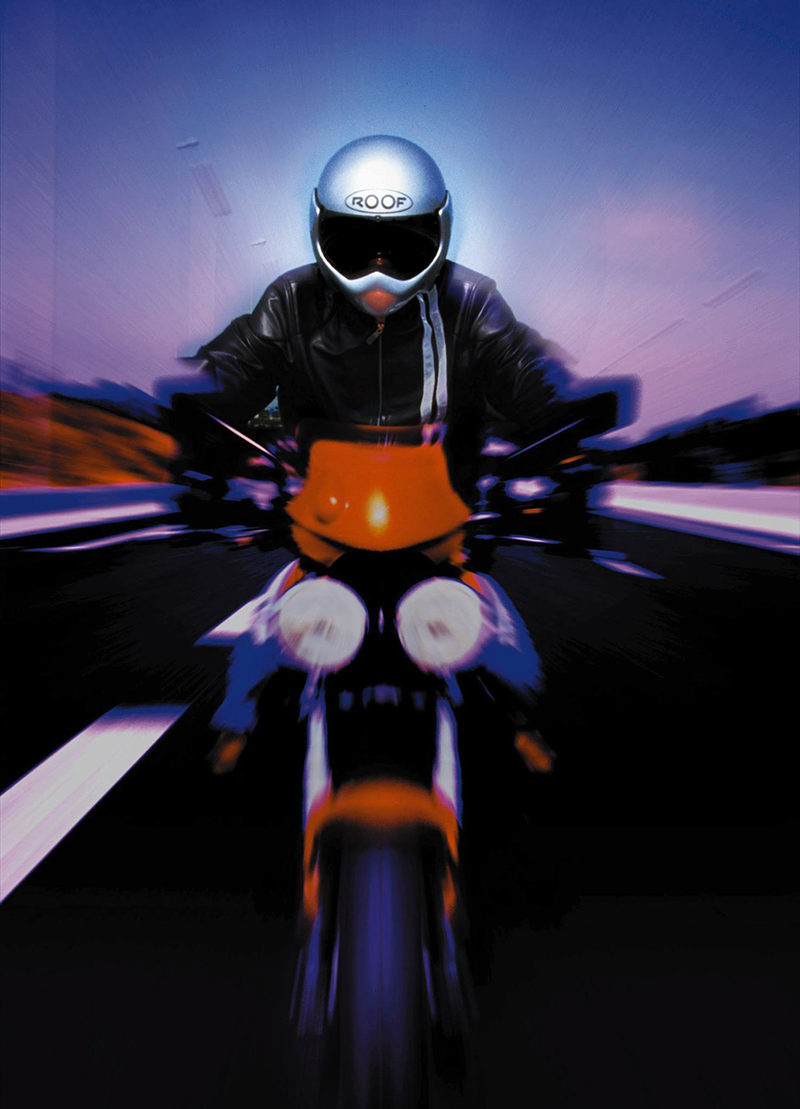
Shark's own interpretation, the original Evoline came along much later; in fact, almost ten years after Monsieur Morin's innovative design was first released to an adoring public. But what Shark realised, even back then, was that, cool-looking as the Boxer was, it was a pretty basic affair with a crude chin bar mechanism, and a very clunky visor arrangement. For many, the Boxer’s main appeal was its Top Gun fighter pilot profile, but fittingly perhaps it could generate almost as much noise as a jet engine, and it wasn't a helmet you ever wanted to get caught out in the rain in.
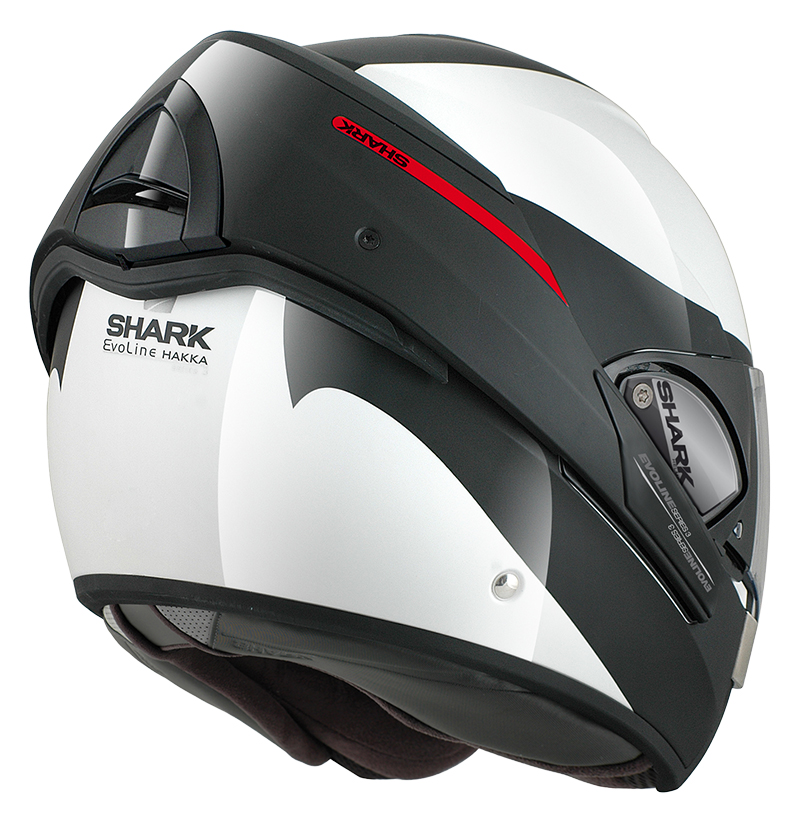
The Shark was a more sophisticated affair. Instead of operating on a single pivot, the chin bar on the Evoline used an elliptical mechanism that allowed the chin bar, in its rear position, to sit flush against the shell of the helmet.
The Evoline went through a number of iterations over the years, each supposedly representing an upgrade in terms of features.
In 2016, Shark brought out its first major re-design of the Evoline, under the Evo-One nomenclature. As ever with the French manufacturer, there was no shortage of hype. Their designers talked a lot about the benefits of much-lauded 'reverse-engineering’ principles, designed to reduce tolerances, remove unnecessary bulk, and improve the fit.
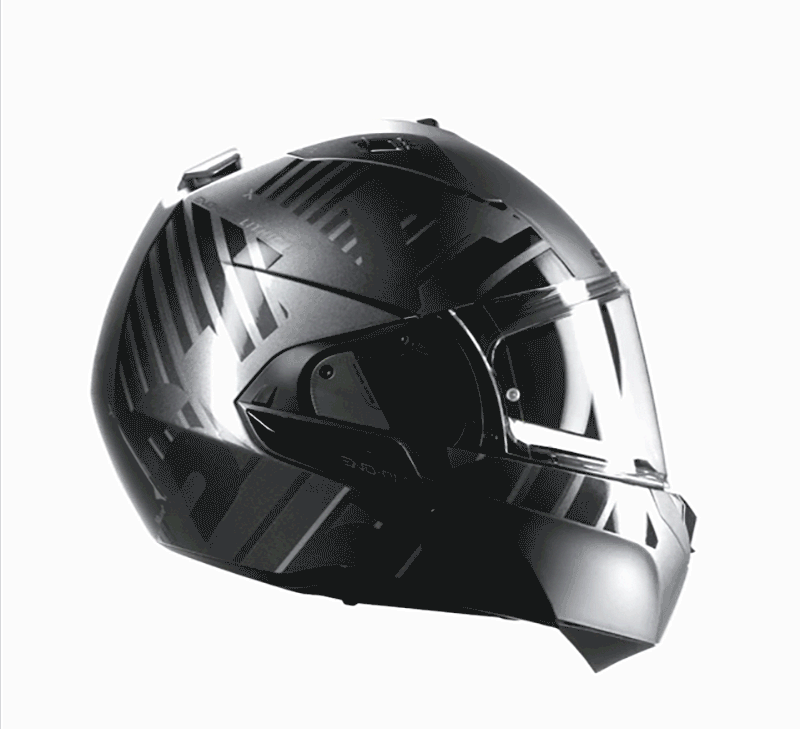
But the main rationale behind the re-design, apparently, was to overcome the need for the rider to raise the main visor before taking the chin bar from the back of the helmet to the front. Now I am not totally sure why anybody thought this was a major issue, but fair enough. And, on a good day, the new mechanism on the Evo-One worked.
The problem was that it only worked on good days. On not so good days it didn't work very well at all. And on bad days, it didn’t work ant anll. All too easily the visor mechanism could be defeated. If you didn't treat the helmet with the kid gloves that were required, the chin bar would get stuck. There was, it would seem, simply too much going on with the pulleys, cams and links that allowed the chin bar and visor to operate in concert.
In a desperate bid to resolve the matter, Shark issued instructions on how to open and close the helmet. As you might expect, that didn't go down well with motorcyclists.
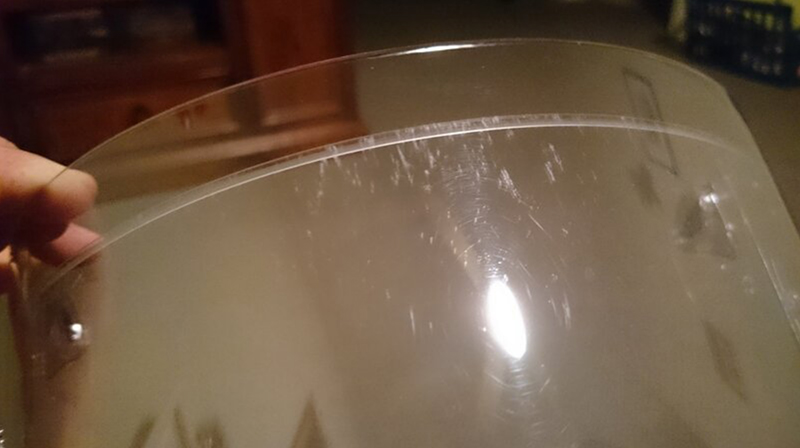
In fairness, it didn't take long for Shark to come up with an upgraded version, but on the new helmet the tolerances were so tight that it caused the upper rim of the visor aperture to leave marks on the Pinlock visor. The Evo-One seemed to be blighted, although we actually quite liked the next 'fix', which entailed supplying the helmet with an anti-fog visor and no Pinlock. That worked for us.
Word has it that heads rolled back in Marseille, although the truth is that there were other Shark helmets at this time that also failed to hit the spot. Of course, the Evo concept was so strong that the helmet still sold extremely well all around the world.
Yet what was clear to all was that a totally new helmet was required. And the new, more rigorous ECE 22-06 safety standard provided the necessary platform for a re-think. The helmet that came out of this process is the new OXO.
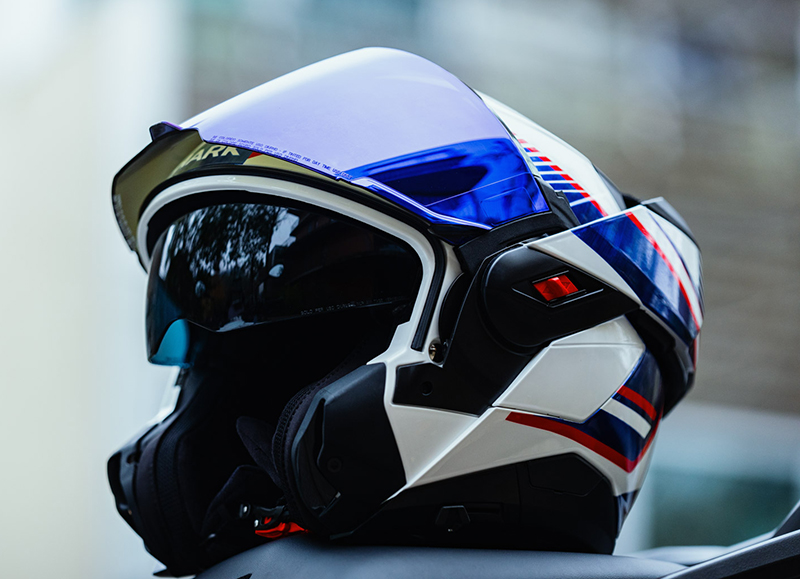
A new beginning
One might have thought, given the vicissitudes experienced by the Evo range of helmets, that Shark would have dialled down a little on the rhetoric with the new helmet. But not a bit of it.
What the French manufacturer tells us is that the OXO combines ‘Shark’s rich heritage of innovation, cutting-edge aerodynamics, unparalleled comfort and advanced safety features to deliver the ultimate versatility for those seeking a seamless transition’!
The helmet’s apparently a ‘revelation in the world of design and comfort. ‘You will’, they state categorically, ‘be captivated by its assertive style. Get ready to take your experience to the next level. This is a helmet designed for those who aspire to merge efficiency, style and comfort’.
Heck, I hope this helmet’s good, if only for the sake of the guy who’s in charge of its marketing!
Anyway, let’s take a look at the helmet itself.
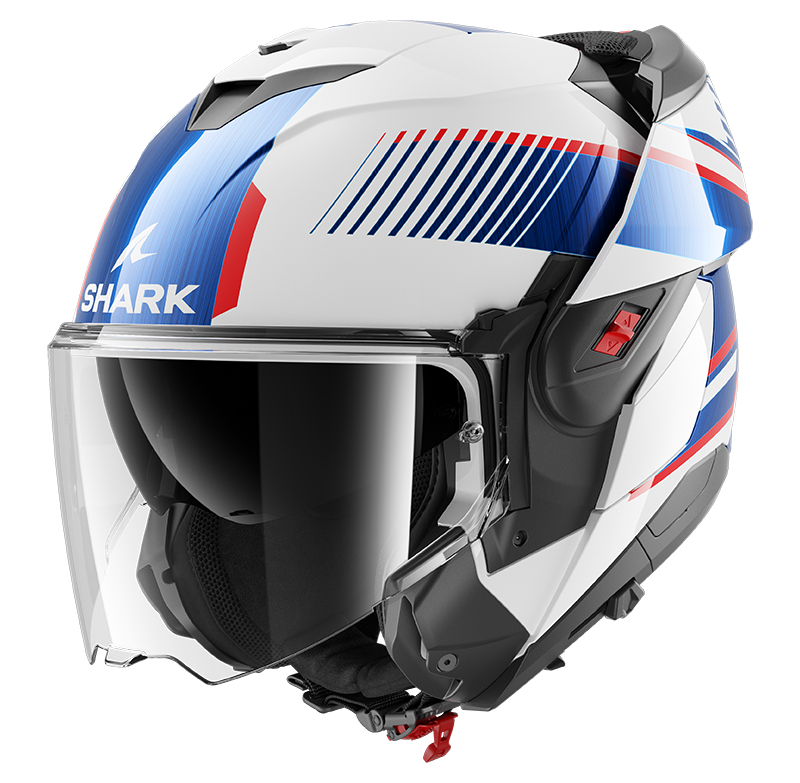
The Shark OXO helmet
Well, there's nothing particularly outstanding or innovative about the technical spec. of the OXO.
The shell is made from a material called Lexan. That means it’s a polycarbonate helmet; a fancy word for plastic. This is not the most sophisticated substrate for a helmet, but plastic helmets are known to be good at absorbing the energy of an impact. Plastic, though, doesn't make for the strongest shells when it comes to multiple impacts, for example.
I recently watched a video on Youtube where the exuberant presenter claimed that Lexan was a composite material. Emphatically, that’s not the case. Lexan is a plastic, although quite a superior one, it has to be acknowledged.
The helmet comes in just two shell sizes. Now three shell sizes is the mark of a truly premium helmet, although it's still the case that most brands have two, including some upmarket ones like, for example, Schuberth.
The OXO comes in six different sizes; from XS to XXL. Interestingly, the helmet has six different eps liner sizes, which means that each helmet will fit differently. And I emphasise this because, in the outlying sizes, some big-name manufacturers still rely on the softer, comfort liners to alter an helmet’s internal dimensions.
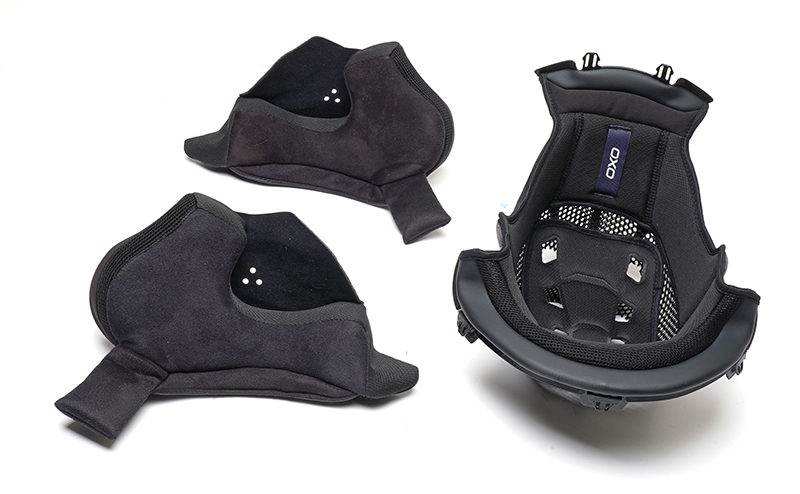
The OXO’s headliners can be removed and washed, by the way, but they cannot be swapped out for ones in different thicknesses. The cheekpads can, however. In fact, in every helmet size you get the option to fit up to five different thicknesses of cheekpad. And that's pretty impressive. Or rather it will be when Shark actually gets round to supplying them!
The internal facings on the OXO are certainly comfortable. Everything feels nice next to the skin, although we're not talking about Shoei levels of sumptuousness here.
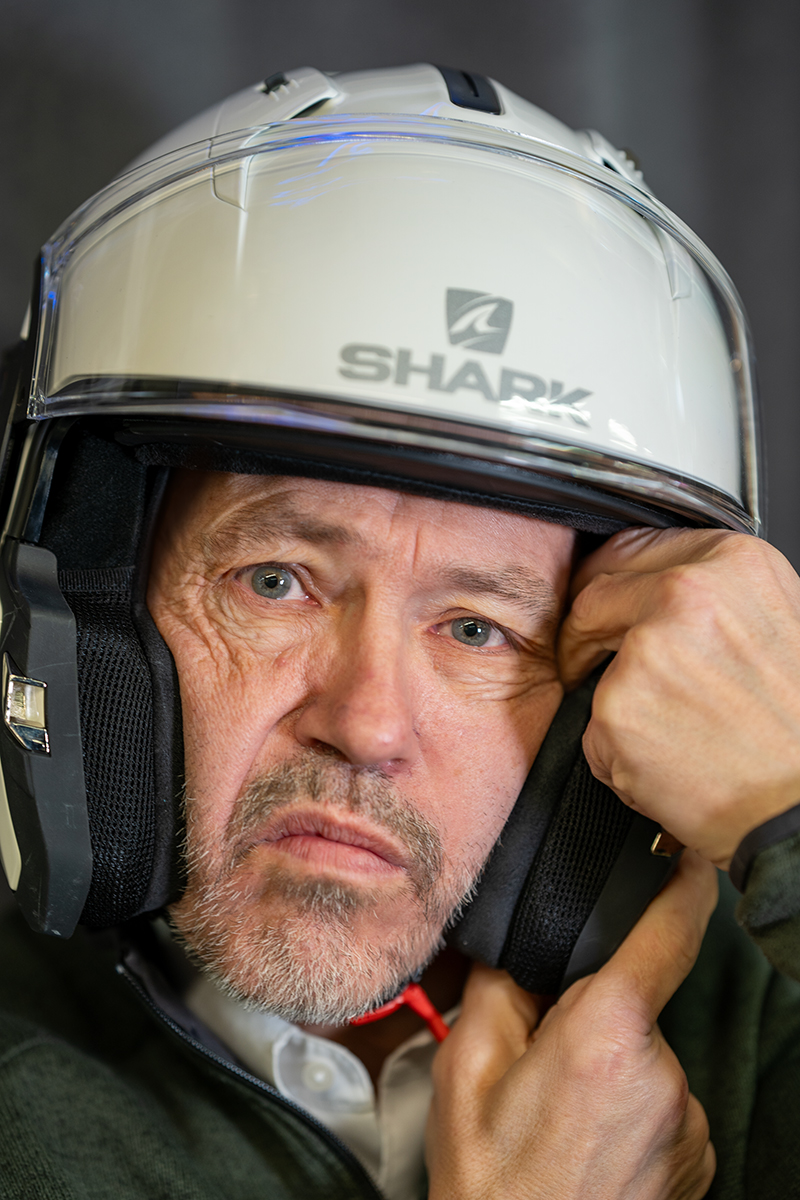
To us, one of the most interesting differences between the old Evo helmets and the OXO is the way it fits. Frankly, the OXO's predecessors had a very idiosyncratic fit. Those helmets were very wide, or round, meaning that they left frequently revealed large open spaces above the cheekbones. The shell then tapered down quite aggressively to the chin, meaning that it could look as though you were wearing a boxing head guard. The result was that the cheeks could be very tight, pinching the mouth, and making it nigh on impossible to chew gum. Or even talk! People got used to it, but there was no other helmet quite like it.
Well, the OXO is very different.
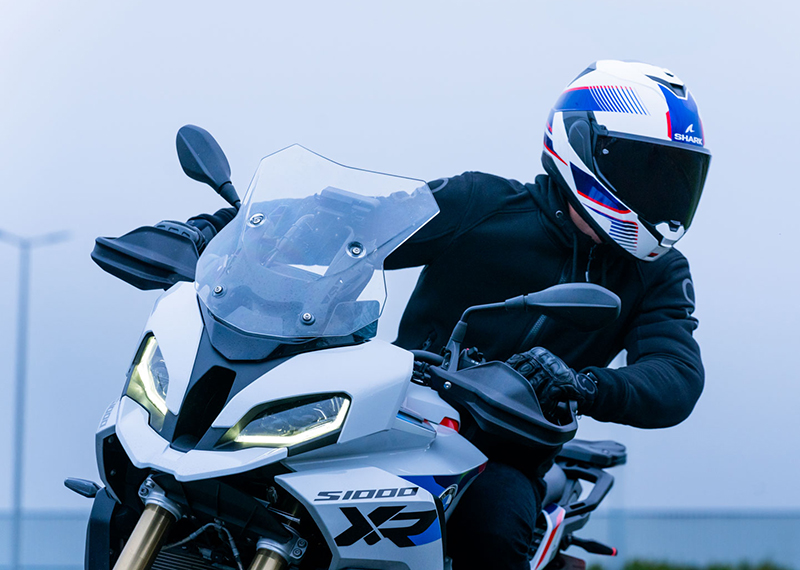
The starting point is that it looks much more like a regular helmet. Okay, because of the lift-over chin bar, it's a touch wider than some full-face helmets, but put it on and, from 10 paces, it looks like any full-face helmet. And that's, in every way, a good thing, in our view.
The helmet wears much more like a full-face helmet too. There are no gaps above the cheeks. As a result, the OXO should be a pretty quiet helmet, we feel. And this is in contrast to the Evo range of helmets, none of which were. Without doubt, however, the internal fit around the cranium is much more oval. Now we don't have a problem with this. But those who wore an Evo because it was the only helmet that didn't pinch the sides of their head may find that the OXO is not so accommodating.
Indeed, the helmet is too oval for me. Before PFS came along, I could never really wear a Shoei helmet because the Shoei shape is quite oval. An Arai helmet works for me, as does a Schuberth helmet normally. In the past a Shark helmet has also fitted me well, but the OXO doesn't. That's not a fault or problem with the helmet. I am merely pointing out that the OXO has an internal shape like no other Shark that has gone before. It feels as though Shark has started with a blank sheet on this one. And indeed that is implied in some of the OXO's marketing blurb. I suspect the OXO will work well for a lot of people but, as ever, not for everybody.
Other stuff?
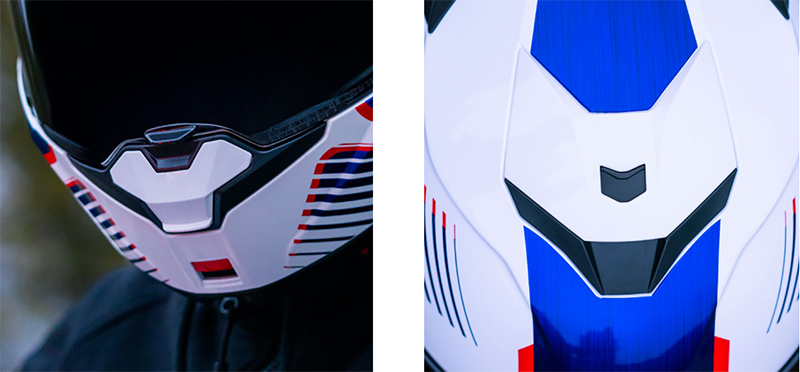
Well you get a chin vent and a brow vent, but they're pretty basic. One position, really, on both. Open or closed.
The outer visor doesn't look as though it's Class 1 optical quality, although it does come with an anti-fog coating. If that isn't up to the job, well you also get a Pinlock 70 in the box. Personally, I thought that Shark had decided to put a 120 into every box. A 70 Pinlock is cheaper for Shark, but it's not as effective in extreme conditions. I have to admit that I find this kind of ‘nickel and diming’ a bit disappointing on such a high-profile brand.
One of the things that Shark normally does better than the other manufacturers is visor detente mechanisms. But the OXO has nothing in this regard, and I figure that this is a price you pay for having a flip-over chin bar, as the Scorpion equivalent is similarly deficient in this particular department.
By contrast, the drop down sun visor is quite clever. It has five different 'click-in’ positions, all of which can be released by depressing a button that sends the visor flying up into the shell.
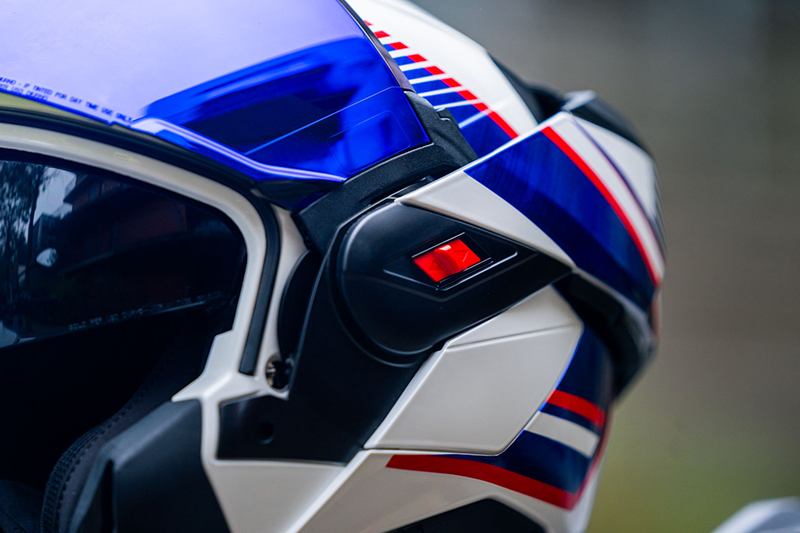
The helmet, obviously, is both P and J rated, so can be ridden legally as either an open-face, or a full-face, helmet. There's a lock position that stops the chin bar from coming forward when it's in its rear position. It's part of ECE 22-06, but it's not something that is really necessary on a flip-over helmet.
Now the OXO, in truth, will stand or fall on the reliability and ease of use of the chin bar's rotation mechanism. We have not moved it forward and back a million times in the manner that I hope that Shark has. All I can say is that it feels tight and robust like Shark's mechanisms in the past never really have done. It feels to me as though it's going to work well, but it's too early to be sure. We'll only really know that six months down the line.
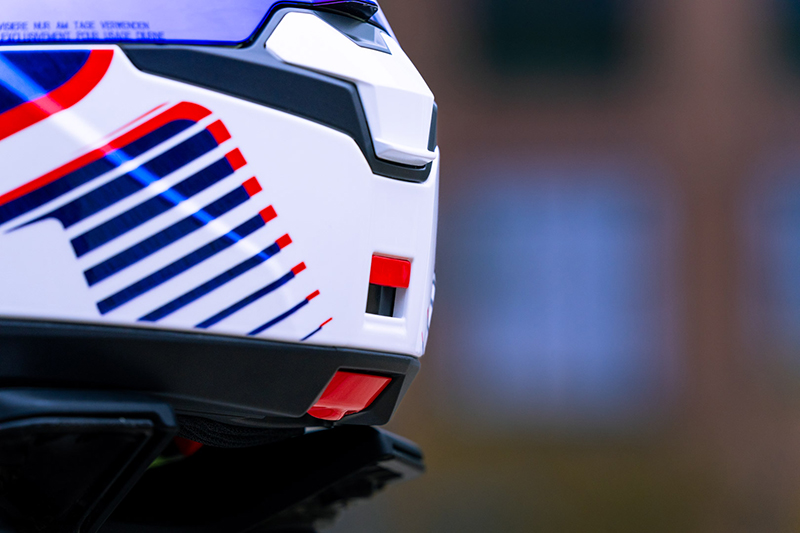
There is, though, one thing that might not work for everybody. And it's the chin bar release mechanism. It's a little bit fiddly, and it requires a pinching action with the thumb and forefinger to make it work. It's not horribly intuitive, and will take a bit of getting used to. I suspect it may be a bit tricky to use with heavy, winter gloves.
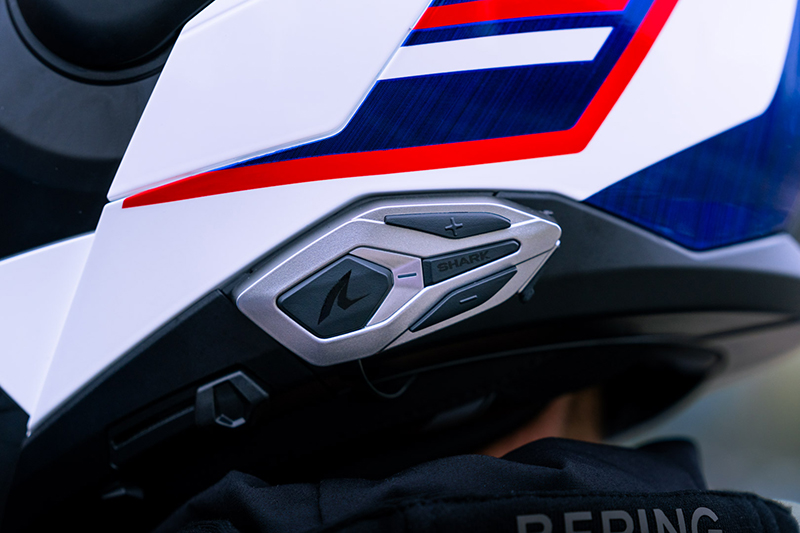
Finally, there's a range of integrated Sena comms. systems that can be fitted into the helmet. There's a more basic Bluetooth system for those who just want to connect to a satnav or phone, or to talk with a pillion or another rider. And then there’s an all-singing-and-all-dancing Mesh system for those who ride in larger groups. Both systems have a 15 hour battery life, and a one-mile talk range. And both come with HD speakers. There is, I'm afraid, no Cardo option. Sticking a Cardo unit onto the shell is possible, but won't be particularly easy to access.
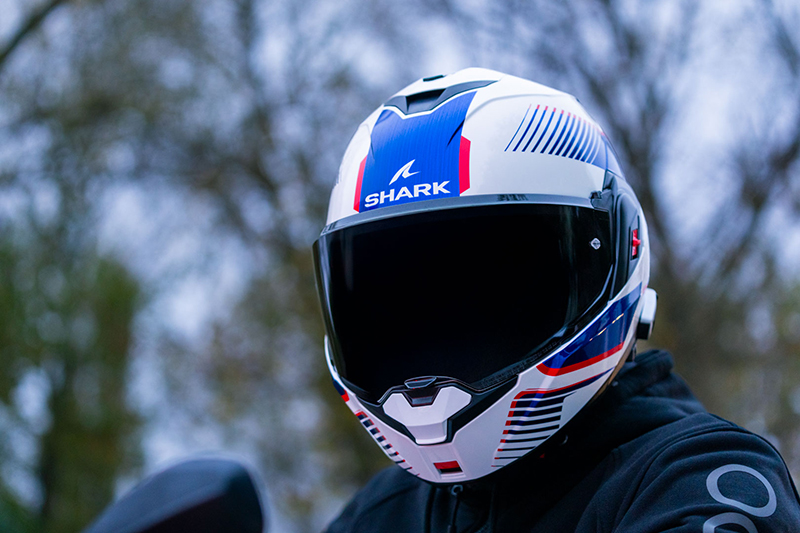
In conclusion
This is a totally new helmet. Nobody, other than perhaps a few people at Shark, have ridden in it, so neither I, nor anybody else, can tell you how it's going to perform for you on the road.
As ever these things are very personal, and how comfortable, quiet or noisy the helmet is going to be will be down to your head shape, the kind of bike you ride, your height, the kind of screen you have, and so on.
Don’t take too much notice of some YouTuber who passes judgement, having ridden around the block in the OXO he has been gifted by Shark; and is soon to put up for sale on Ebay! And don't be persuaded by anybody who slaps measuring and monitoring devices on to the helmet, and assigns scores to its features. That's the kind of old baloney that would have been pedalled by snake-oil salesman back in the day.
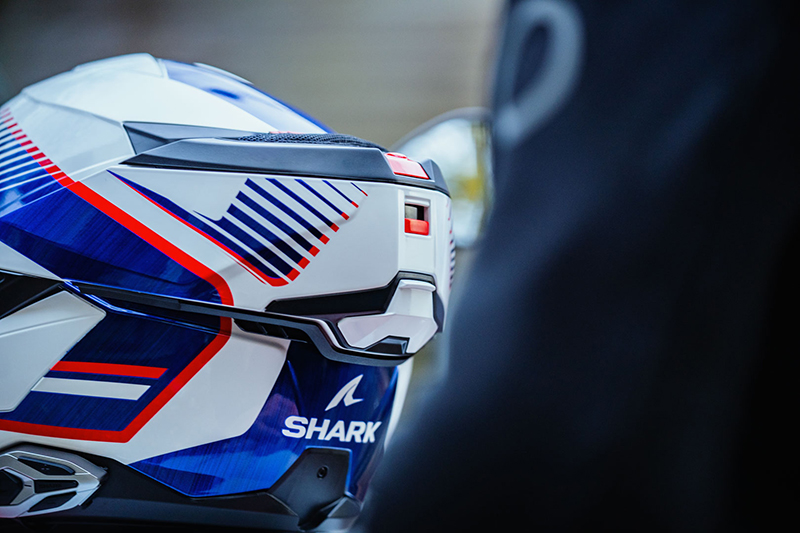
What we can be fairly definitive about, however, is that the OXO is a big step up from the old Evo range. It feels more solid, better designed and better engineered than any of its flip-over predecessors.
We think it looks much more like a regular helmet, and certainly it wears much more like one too.
The Evo range of helmets was never particularly mainstream. They gave riders the option to ride with either an open-face helmet or a full-face helmet, but the truth was that the Evos were not great to ride in. They were too noisy for motorway riding, a tad on the flimsy side, and not always particularly reliable. Well, the OXO looks and feels very different. In fact, it simply feels better. Will it prove to be a great helmet? We don't know that yet. But is it an improvement upon its predecessor? You can bet on it.
As you would expect, the helmet comes in a number of colours and graphics. The basic, plain colours come in at just over £300. The graphics come in at around £350.
(On some websites you will see that the OXO is being discounted by 5%. Our prices reflect that discount).
The OXO is no Shoei Neotec 3, but it doesn’t pretend to be. If it's a flip-over helmet that you want, as opposed to a flip-up one, then the OXO needs to be on your shopping list. In fact, from what we have seen, it should probably be at the top of it.
You can buy a Shark OXO helmet with free next day UK delivery online, or visit our store in Guildford to try it one on.
Share this story
































































